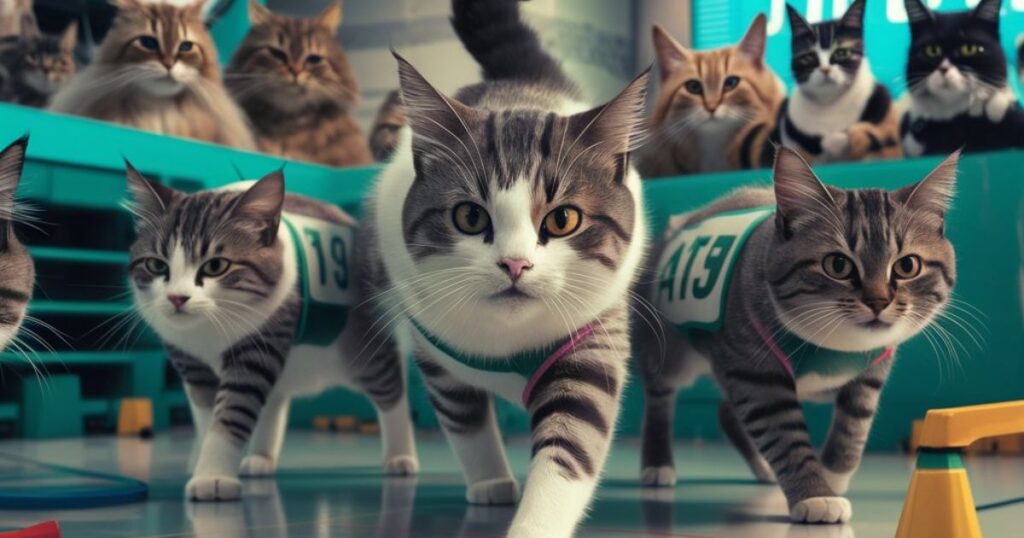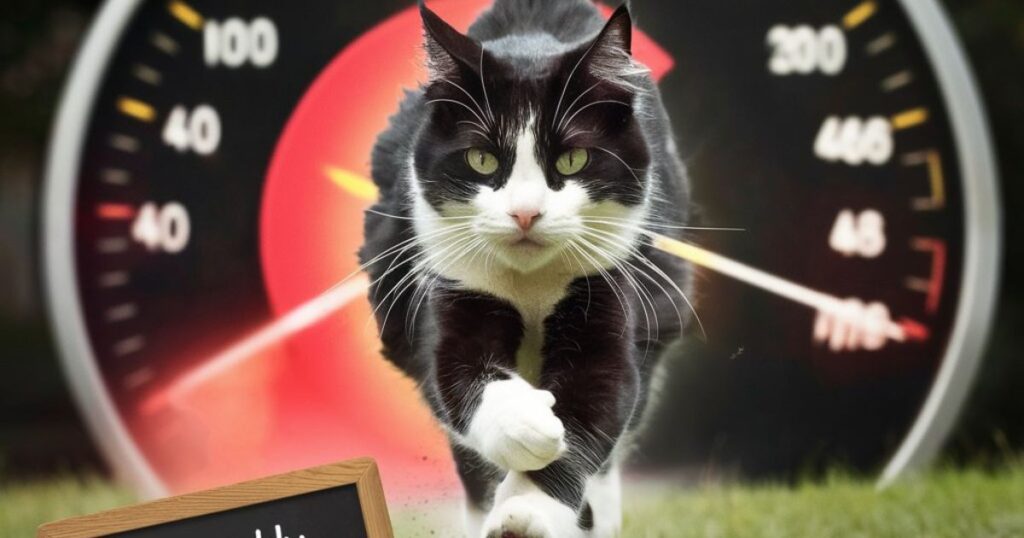From streaking across the living room to dashing up trees, cats display an incredible burst of speed that often leaves us awestruck. But have you ever wondered just how fast these furry felines can truly run? Understanding the remarkable pace at which cats can move requires an in-depth exploration of their unique anatomy, breed variations, and the evolutionary origins of their need for speed.
1. Understanding Feline Anatomy for Speed
At the core of a cat’s ability to reach impressive speeds lies their unique anatomical structure. These agile creatures possess a muscular composition designed for explosive power and agility.
Their lightweight yet sturdy skeletal framework, coupled with a flexible spine, allows for quick directional changes without losing momentum. Their aerodynamic body design and paws equipped with gripping claws enable maximum traction, propelling them forward with each stride.
2. Fastest Cat Breeds

While all domestic cats are capable of impressive bursts of speed, certain breeds stand out for their exceptional velocity. The Egyptian Mau, renowned for its sleek and athletic build, has been clocked reaching speeds up to an astonishing 30 mph. Similarly, the slender and long-legged Abyssinian possesses a natural talent for rapid acceleration, making it a formidable sprinter.
The Bengal, a breed that inherited its wild cat genes from the Asian Leopard Cat, is another contender for the feline speed throne. Other notable swift breeds include the lithe Siamese, the athletic Oriental, and the stunning Savannah cat, a hybrid that combines the speed of its Serval ancestor with the domestic cat’s agility.
3. Factors Influencing a Cat’s Running Speed
While breed plays a significant role in a cat’s top speed potential, several other factors can influence their running capabilities. Age and physical conditioning are crucial determinants, as younger and more active cats tend to outpace their older or sedentary counterparts.
Environmental factors, such as terrain, weather conditions, and whether the space is enclosed or open, can also impact a cat’s willingness and ability to reach peak velocities.
A cat’s motivation, whether driven by prey drive, playful instincts, or fear, can significantly impact their running speed. Obstacles and distractions in their path can also pose challenges, forcing them to adjust their pace and maneuverability accordingly.
Read More Post : How To Declaw A Cat At Home
4. Speed Metrics: How to Measure a Cat’s Speed
Measuring a cat’s speed requires innovative techniques and specialized equipment. High-speed cameras, capable of capturing hundreds or even thousands of frames per second, have proven invaluable in analyzing feline sprints. These cameras allow researchers to break down each stride and calculate the exact speed at which the cat is moving.
Motion sensors and laser timing gates have been employed to accurately measure a cat’s speed over a set distance. By comparing the times of domestic cats with their wild counterparts, such as cheetahs and jaguars, researchers can gain valuable insights into the speed capabilities of different feline species.
Here’s a table comparing the top speeds of various cat breeds:
| Breed | Top Speed (mph) |
| Egyptian Mau | 30 |
| Abyssinian | 28 |
| Bengal | 27 |
| Siamese | 25 |
| Oriental | 24 |
| Savannah | 30 |
5. Record-Breaking Feline Speeds

Throughout history, instances of cats achieving astonishing speeds have been documented, both in the domestic and wild realms. While the average house cat can reach speeds of around 30 mph in short bursts, there have been extraordinary cases of domestic cats clocked at over 35 mph.
In the wild, the cheetah reigns supreme, with its renowned top speed of an incredible 75 mph. This remarkable feat is the result of millions of years of evolution, honing the cheetah’s body for the ultimate hunting machine.
Other impressive feats from the feline world include the jaguar, capable of reaching speeds up to 65 mph, and the lion, known for its incredible acceleration and top speed of around 50 mph over short distances.
6. Evolutionary Significance of Cat Speed
A cat’s need for speed can be traced back to its evolutionary roots, where speed played a crucial role in survival. For wild cats, the ability to swiftly chase down and capture prey was essential for sustaining their existence. Conversely, the capacity to rapidly flee from predators or defend their territory was equally vital for their preservation.
While domestic cats no longer rely on speed for hunting or survival in the same way as their wild counterparts, their deeply ingrained instincts and agility remain intact. This inherited trait continues to manifest in their playful antics and occasional bursts of speed, even in the comfort of our homes.
7. Common Misconceptions About Cat Speed
Despite the wealth of information available, several misconceptions about cat speed persist. One common myth is that certain breeds, such as the Persian or British Shorthair, are inherently “slow” due to their stocky builds. However, breed alone does not determine a cat’s speed potential, as factors like age, physical conditioning, and motivation play equally significant roles.
Another assumption is that older cats naturally lose their speed as they age. While it’s true that a cat’s physical abilities may decline with age, regular exercise and a healthy lifestyle can help maintain their agility and sprinting capabilities well into their senior years.
8. Training and Exercise for Enhancing Cat Speed

While a cat’s speed is largely determined by their breed and natural abilities, there are ways to enhance and maintain their agility and quickness. Environmental enrichment and regular playtime are crucial for building and honing a cat’s speed and agility.
Interactive toys, such as laser pointers, feather wands, and puzzle feeders, can encourage your feline friend to engage in short bursts of speed and quick movements. Specialty products like the Athlecat Cat Exercise Wheel provide a safe and controlled environment for cats to run, jump, and play, improving their overall physical condition and speed capabilities.
FAQs about Cat Speed:
How fast can the average house cat run?
The average domestic cat can reach speeds of around 30 mph in short bursts, with some exceptional individuals reaching over 35 mph.
Are male or female cats typically faster?
While there may be slight variations, gender alone does not significantly impact a cat’s top speed potential. Factors like breed, age, and physical conditioning play a more significant role.
Do indoor cats run as quickly as outdoor cats? A
Indoor cats may not have as many opportunities to engage in full-out sprints, but with regular exercise and environmental enrichment, they can maintain their speed and agility comparable to their outdoor counterparts.
Can exercises to improve cat speed be harmful?
While exercises and training can enhance a cat’s speed and agility, it’s crucial to approach them responsibly and gradually. Sudden intense activity or improper techniques can lead to injuries or burnout. Consulting with a veterinarian or feline behaviorist is recommended.
Are there any scientific studies on cat speed measurement techniques?
Yes, researchers have employed various techniques. Such as high-speed cameras, motion sensors, and laser timing gates, to accurately measure and analyze the speed of cats in controlled environments.
Conclusion
From their finely tuned body mechanics to their deep-rooted hunting instincts, a cat’s speed is a true marvel of nature and evolution. Whether you’re in awe of your furry friend’s Olympic-worthy sprints or simply appreciate their athleticism. Understanding their rapid pace offers insights into the remarkable creatures we share our homes with.







